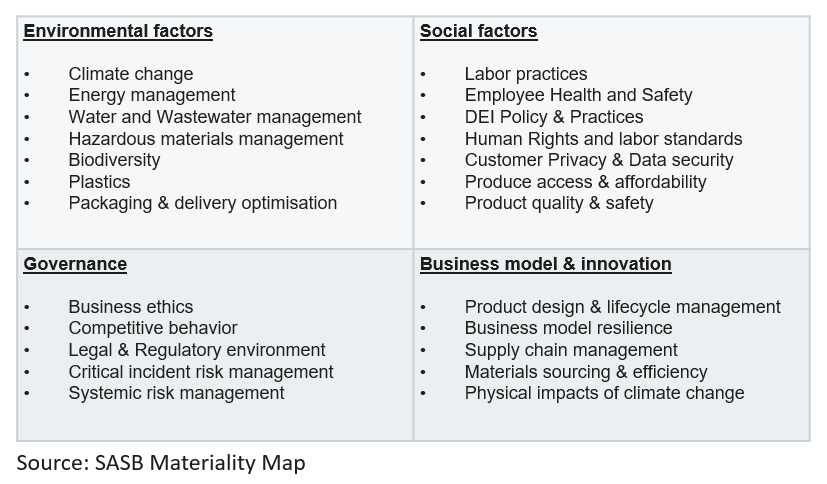ESG due diligence za M&A transakcije: Identificiranje rizika i prilika

Problemi zaštite okoliša, društva i upravljanja ("ESG") sve više utječu na sklapanje poslova i transakcije spajanja i preuzimanja. Kupci postaju itekako svjesni kako ESG diligence može identificirati različite rizike i prilike koji mogu utjecati na procjenu vrijednosti na načine koji se ne mogu lako identificirati tradicionalnim due diligenceom. Nadalje, kupci razumiju potrebu za razmatranjem utjecaja povećanih regulatornih zahtjeva, zahtjeva investitora i kupaca na aktivnosti cilja.
Razmatranje rizika
ESG diligence sagledava ciljni profil rizika procjenom ESG čimbenika za koje je razumno vjerojatno da će značajno utjecati na financijsko stanje tvrtke, operativne rezultate ili tržišnu procjenu. Materijalni ESG čimbenici identificirani su pomoću standarda Odbora za standarde održivog poslovanja (SASB), koje je usvojio Međunarodni odbor za standarde održivosti (ISSB).
Uključivanjem ESG informacija u odluke o ulaganju, kupci mogu iznijeti na vidjelo rizike koji se često zanemaruju u tradicionalnim dubinskim analizama.
- Način na koji se postupa s opasnim otpadom i kako se on zbrinjava može značajno povećati izloženost odgovornosti kupca/zajmodavca.
- Ozljede na radnom mjestu i druga pitanja povezana sa sigurnošću povećavaju izloženost tvrtke podvezivanju i prekidima rada.
- Kršenje ljudskih prava u opskrbnom lancu može povećati rizik za reputaciju i dovesti do sankcija vlade.

Općenito govoreći, poslovne aktivnosti izložene novčanim kaznama, sudskim sporovima, radničkim nemirima, državnim sankcijama ili narušavanju ugleda područja su u kojima ESG može pomoći kupcu da bolje razumije profil rizika ciljne tvrtke, a kao što je prikazano u nastavku, neuspjeh u razmatranju ESG rizika može rezultirati potpuni otpis ulaganja.
Case Study – Prava siromašnih
Godine 2021. norveški Vrhovni sud presudio je da park vjetrenjača vrijedan milijardu eura na području Samija krši domorodačka prava Samija. Sud je presudio da postavljanje parka vjetroturbina koje sprječava ili ograničava Samijevo bavljenje uzgojem sobova krši njihova domorodačka prava i mora biti uklonjeno ako se ne pronađe rješenje za ublažavanje. Da su ulagači odvagnuli važnost norveških prava na siromaštvo u svojoj dubinskoj procjeni prije ulaganja, danas se ne bi suočili s potpunim gubitkom svog ulaganja.
Razmatranja mogućnosti
ESG diligence ne samo da identificira potencijalne rizike, već može pomoći u prepoznavanju dugoročnijih prilika za uštedu troškova, rast prihoda i poboljšanu učinkovitost. To je osobito istinito jer se preferencije potrošača i državni prioriteti kreću prema održivim proizvodima i usklađuju s prijelazom na gospodarstvo s niskom razinom ugljika. Kupci koji uključuju održivost u svoje modele vrednovanja mogu bolje kvantificirati dugoročnu vrijednost i kapitalizirati trendove održivosti koji značajno povećavaju terminalnu vrijednost ulaganja.
Područja mogućnosti općenito su usredotočena na proizvodne metode tvrtke, prodane proizvode, bazu kupaca i utjecaj na okoliš. Primjeri prilika uključuju:
- Operater odmarališta nastoji ponovno uspostaviti lokalnu bioraznolikost na svom terenu i okolnom području kako bi povećao svoju privlačnost za goste. To je također dovelo do sekundarnog toka prihoda od prodaje ugljičnih kredita, što je dodatno pridonijelo projiciranoj izlaznoj procjeni.
- Proizvođač betona čiji se kupci nalaze u EU-u stvara inovativni proces koji smanjuje ugljični otisak betona za 85%, a istovremeno odgovara čvrstoći i cijeni tradicionalnog betona s visokim udjelom ugljika.
- REIT kupuje nekoliko brownfield nekretnina koristeći prednost "zelenih" državnih subvencija i poreznih olakšica prilikom strukturiranja transakcije i procjene budućih kapitalnih ulaganja.
- Kupac identificira kako ciljna tvrtka za online dostavu može redizajnirati pakiranje kako bi smanjila troškove i materijale za 50%. Dodatno podupirući njihovu obrazloženost dogovora.
Case Study – Inovativni proces
Velik dio svjetskog litija nalazi se u južnoameričkim pustinjama i sakuplja se procesom poznatim kao ekstrakcija salamure. Ekstrakcija slane vode uključuje pumpanje 500.000 galona litijeve slane vode na površinu kako bi se stvorila jedna tona litija. Otopljena slana otopina pumpa se u bazene za isparavanje, gdje su potrebne gotovo dvije godine da bazeni ispare dok se pritom povrati samo 20-40% ekstrahiranog litija. Ekstrakcija slane vode iznimno je intenzivna, što rezultira značajnim poteškoćama lokalnim poljoprivrednim zajednicama.
Kako bi rudarenje litija bilo održivije, nekoliko je tvrtki razvilo i patentiralo novi postupak izravne ekstrakcije litija (DLE). DLE je proces koji koristi visoko selektivan apsorbent za izdvajanje litija iz slane vode i prijenos u drugi medij za daljnju obradu. To je jeftin, visokoučinkovit i ekološki prihvatljiv način za proizvodnju visokokvalitetnog litija i može doseći stopu oporavka od 90%. DLE tehnologija ubrzava proces koncentracije litija, reciklira vodu korištenu u procesu i smanjuje potrebu za velikim bazenima za isparavanje.
Kako bi prevladao protivljenje zajednice, Standard Lithium je uspješno implementirao DLE u svoje rudarske operacije u Arkansasu i sada ga koristi kao model za buduće mogućnosti rudarenja.
Postoji mnogo načina na koje se dugoročne prilike identificiraju u poslu. Ponekad su to prodavateljeve ESG izjave, a ponekad je to ESG stručnjak koji identificira priliku koju bi tim za dogovor trebao istražiti. Većina neodrživih aktivnosti može postati održiva uz određenu cijenu. Pitanje je ima li cilj inovativno, održivo rješenje s pozitivnim povratom?
Regulatorna i korisnička razmatranja
Vlade i kupci nameću značajne održive standarde tvrtkama koje posluju u njihovoj nadležnosti ili lancu opskrbe. Ova se pravila ne primjenjuju samo na lokalne operacije, već i na njihove uzvodne i nizvodne utjecaje.
Europska unija stvorila je klasifikacijski sustav taksonomije EU za održive poslovne aktivnosti kako bi podržala prijelaz na održivije gospodarstvo. Među mnogim stvarima, Taksonomija EU identificira održive aktivnosti industrije koje "ne štete". Zbog načina na koji su SFDR (direktiva o izvješćivanju za upravitelja alternativnih investicijskih fondova (AIFM)) i EU taksonomija međusobno povezani, ulaganja u kategoriji "ne šteti" imaju znatno veću publiku u EU na izlazu. U kontekstu spajanja i preuzimanja, kupci mogu koristiti taksonomiju EU-a za procjenu njezinog utjecaja na potencijalnu ciljanu tvrtku i identificirati prilike za stvaranje vrijednosti i upravljanje rizikom.
U SAD-u je SEC objavio nekoliko ESG prijedloga. Najdalekosežniji prijedlog je da sva javna poduzeća objavljuju određene podatke o klimi. Ove objave uključuju izvješćivanje o emisijama stakleničkih plinova i izloženosti riziku povezanom s klimom. Prijedlog klimatskog izvješćivanja uključuje okvir Radne skupine za financijske objave povezane s klimom (TCFD), koji većina javnih poduzeća tek treba usvojiti. Razumijevanje troškova provedbe klimatskih mjera i načina na koji takvo izvješćivanje može utjecati na buduće procjene treba razmotriti tijekom procesa spajanja i preuzimanja.
Dobavljači također osjećaju pritisak i od svojih kupaca i od regulatora. Ciljane tvrtke koje opskrbljuju javna poduzeća moraju biti u stanju objasniti svoje politike i postupke koji se odnose na ciljeve ljudskih prava, raznolikosti i emisija stakleničkih plinova. Tvrtke koje kupuju pamuk i solarne ploče moraju uzeti u obzir američki Zakon o sprječavanju prisilnog rada Ujgura i način na koji se dokumentira usklađenost.
Zaključak
Informacije o ESG-u nikada ne bi trebale biti jedini ili primarni faktor u donošenju odluke o ulaganju. ESG diligence namijenjen je pružanju dodatnih informacija prilikom procjene transakcije. Povećanjem razine dostupnih informacija, kupci će imati cjelovitiji pogled koji im može pomoći da izbjegnu loša ulaganja i potaknu prilike koje povećavaju povrat. Također je bitno u današnjem svijetu uzeti u obzir održivost i jednakost tijekom procesa ulaganja. Neuspjeh da se uzmu u obzir ova glavna pitanja mogu stvoriti neočekivane posljedice koje su se mogle izbjeći prije zatvaranja.
Explore our featured insights

Kakvo god bilo vaše pitanje, naš tim uputit će vas u pravom smjeru








